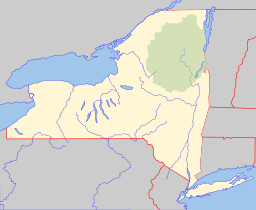Trout Lake (Warren County, New York) facts for kids
Quick facts for kids Trout Lake |
|
|---|---|
| Location | Warren County, New York, United States |
| Coordinates | 43°32′16″N 73°42′16″W / 43.5377039°N 73.7045568°W |
| Type | Lake |
| Primary outflows | Huddle Brook |
| Basin countries | United States |
| Surface area | 254 acres (1.03 km2) |
| Average depth | 20 feet (6.1 m) |
| Max. depth | 75 feet (23 m) |
| Shore length1 | 3.7 miles (6.0 km) |
| Surface elevation | 787 feet (240 m) |
| Islands | 1 |
| Settlements | Bolton, New York |
| 1 Shore length is not a well-defined measure. | |
Trout Lake is a beautiful lake located west of Bolton, New York. It is found in Warren County, New York, within the United States. This lake gets its name because many different kinds of trout live there.
About Trout Lake
Trout Lake is a freshwater lake in New York. It covers an area of about 254 acres (1.03 square kilometers). The lake is not very deep in most places, averaging about 20 feet (6.1 meters). However, its deepest point reaches about 75 feet (23 meters). The shoreline of Trout Lake stretches for about 3.7 miles (6.0 kilometers). It sits at an elevation of 787 feet (240 meters) above sea level. Only one island can be found in the lake.
What Lives in the Lake?
Trout Lake is home to many different kinds of fish. As its name suggests, it has a lot of trout species. You can find brook trout, rainbow trout, splake, lake trout, and brown trout here.
Besides trout, other fish also live in the lake. These include smallmouth bass, largemouth bass, and pickerel. You might also spot yellow perch, smelt, rock bass, rainbow smelt, and brown bullhead. This variety makes it a great place for fishing.
Visiting Trout Lake
If you want to visit Trout Lake, there is a special trail. You can find a "carry down" trail on the northeast side of the lake. This trail is off Lamb Hill Road. It helps people get to the water.
There are rules to keep the lake healthy and safe. For example, boats on Trout Lake have a motor limit. This means boat engines cannot be more powerful than 50 horsepower. This rule helps protect the lake's environment and wildlife.



